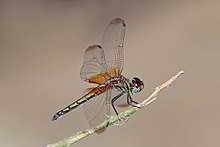Crimson marsh glider
| Crimson marsh glider | |
|---|---|

| |
| Male | |

| |
| Female | |
| Scientific classification | |
| Domain: | Eukaryota |
| Kingdom: | Animalia |
| Phylum: | Arthropoda |
| Class: | Insecta |
| Order: | Odonata |
| Infraorder: | Anisoptera |
| Family: | Libellulidae |
| Genus: | Trithemis |
| Species: | T. aurora
|
| Binomial name | |
| Trithemis aurora (Burmeister, 1839)
| |
| Synonyms[2] | |
| |
Trithemis aurora, the crimson marsh glider, is a species of dragonfly in the family Libellulidae. It is a common and widely distributed species found throughout the year across the Indian subcontinent and Southeast Asia.[1][3]
Description[edit]
The male of this small species is distinctly different from the female. The male has a reddish-brown face, with eyes that are crimson above and brown on the sides. The thorax is red with a fine, purple pruinescence. The abdomen, the base of which is swollen, is crimson with a violet tinge. The wings are transparent with crimson venation and the base has a broad amber patch. The wing spots are a dark reddish-brown and the legs are black.[4][5][6]
-
Male
-
Female
-
female
-
Emergence
The female has an olivaceous or bright reddish-brown face with eyes that are purplish-brown above and grey below. The thorax is olivaceous with brown median and black lateral stripes. The abdomen is reddish-brown with median and lateral black markings. The black markings are confluent at the end of each segment and enclose a reddish-brown spot. The wings are transparent with brown tips. The venation is bright yellow to brown and basal amber markings are pale. The wing spots are a dark brown and the lags are dark grey with narrow yellow stripes.[7][4][8][5][6]
Habitat[edit]
It is commonly found in weedy tanks and ponds, marshes, channels, and slow flowing streams and rivers in the lowlands and mid-hills. It breeds in streams, rivers, canals, ponds and tanks.[4]
Photo gallery[edit]
-
Male
-
Female
-
Male
See also[edit]
References[edit]
- ^ a b Subramanian, K.A.; Dow, R.A. (2010). "Trithemis aurora". IUCN Red List of Threatened Species. 2010: e.T167395A6341159. doi:10.2305/IUCN.UK.2010-4.RLTS.T167395A6341159.en. Retrieved 20 November 2021.
- ^ Paulson, D.; Schorr, M.; Abbott, J.; Bota-Sierra, C.; Deliry, C.; Dijkstra, K.-D.; Lozano, F. (2023). "World Odonata List". OdonataCentral, University of Alabama. Retrieved 14 Mar 2023.
- ^ K.A., Subramanian; K.G., Emiliyamma; R., Babu; C., Radhakrishnan; S.S., Talmale (2018). Atlas of Odonata (Insecta) of the Western Ghats, India. Zoological Survey of India. pp. 389–390. ISBN 9788181714954.
- ^ a b c C FC Lt. Fraser (1936). The Fauna of British India, including Ceylon and Burma, Odonata Vol. III. Red Lion Court, Fleet Street, London: Taylor and Francis. pp. 383-385.
- ^ a b "Trithemis aurora Burmeister, 1839". India Biodiversity Portal. Retrieved 2017-02-17.
- ^ a b "Trithemis aurora Burmeister, 1839". Odonata of India, v. 1.00. Indian Foundation for Butterflies. Retrieved 2017-02-17.
- ^ Subramanian, K. A. (2005). Dragonflies and Damselflies of Peninsular India (PDF).
- ^ C FC Lt. Fraser (1924). A Survey of the Odonate (Dragonfly) Fauna of Western India and Descriptions of Thirty New Species (PDF). p. 439.
External links[edit]
![]() Data related to Trithemis aurora at Wikispecies
Data related to Trithemis aurora at Wikispecies
![]() Media related to Trithemis aurora at Wikimedia Commons
Media related to Trithemis aurora at Wikimedia Commons








